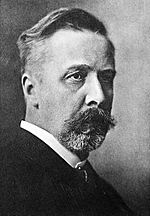Gustav Heinrich Johann Apollon Tammann facts for kids
Quick facts for kids
Gustav Tammann
|
|
|---|---|

Gustav Tammann in 1913
|
|
| Born | 9 June 1861 Yamburg, Russian Empire
|
| Died | 17 December 1938 (aged 77) |
| Nationality | Baltic German |
| Alma mater | University of Dorpat |
| Awards |
|
| Scientific career | |
| Fields | Physical chemistry |
| Academic advisors | Carl Schmidt |
| Doctoral students | Iris Runge |
Gustav Heinrich Johann Apollon Tammann (born June 9, 1861 – died December 17, 1938) was a famous scientist. He was a Baltic German chemist and physicist. He made big discoveries in many areas. These included how glass forms and how different metals mix. He also studied how things crystallize and the science of metals.
Gustav Tammann's Life
Gustav Tammann was born in a place called Yamburg. This town is now in Leningrad Oblast. His father, Heinrich Tammann, was from an Estonian farming family. His mother, Matilda Schünmann, was of German background.
Gustav studied chemistry at the University of Dorpat. Later, in 1903, he moved to Göttingen University. There, he started the very first Institute of Inorganic Chemistry in Germany. This was a big deal!
In 1908, he became the director of the Physico-Chemical Institute. He was very interested in how metals work. He also studied how different metals combine to form alloys. This field is called metallurgy.
Tammann was recognized for his important work. In 1925, he received the Liebig Medal. In 1936, he was given the Eagle Shield of the German Empire. This award called him "The Doyen of German Metallurgy." This means he was considered a leading expert in the study of metals.
He is also known for some important scientific equations. These include the Vogel-Fulcher-Tammann equation. He also helped create the Tait-Tammann equation of state. These equations help scientists understand how liquids behave. They also explain how glass forms.
Gustav Tammann passed away in Göttingen when he was 77 years old.
Awards and Recognition
Gustav Tammann received several important awards for his scientific work:
- The Liebig Medal in 1925. This was from the Association of German Chemists.
- The Heyn Medal in 1929. This award came from the German Society for Materials Science.
- The Eagle Shield of the German Empire in 1936.
A special award, the Tammann Commemorative Medal, is named after him. The German Society for Materials Science gives out this medal.
See also
 In Spanish: Gustav Tammann para niños
In Spanish: Gustav Tammann para niños

